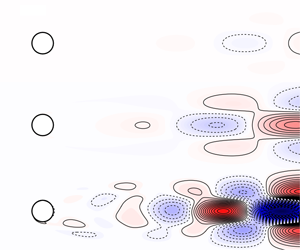Article contents
Feedback control of vortex shedding using a resolvent-based modelling approach
Published online by Cambridge University Press: 17 June 2020
Abstract

An investigation of optimal feedback controllers’ performance and robustness is carried out for vortex shedding behind a two-dimensional cylinder at low Reynolds numbers. To facilitate controller design, we present an efficient modelling approach in which we utilise the resolvent operator to recast the linearised Navier–Stokes equations into an input–output form from which frequency responses can be computed. The difficulty of applying modern control design techniques to high-dimensional flow systems is overcome by using low-order models identified from frequency responses. These low-order models are used to design optimal controllers using  ${\mathcal{H}}_{\infty }$ loop shaping. Two distinct single-input single-output control arrangements are considered. In the first arrangement, a velocity sensor located in the wake drives a pair of body forces near the cylinder. Complete suppression of shedding is observed up to
${\mathcal{H}}_{\infty }$ loop shaping. Two distinct single-input single-output control arrangements are considered. In the first arrangement, a velocity sensor located in the wake drives a pair of body forces near the cylinder. Complete suppression of shedding is observed up to  $Re=110$. Due to the convective nature of vortex shedding and the corresponding time delays, we observe a fundamental trade-off: the sensor should be close enough to the cylinder to avoid excessive time lag, but it should be kept sufficiently far from the cylinder to measure unstable modes developing downstream. These two conflicting requirements become more difficult to satisfy for larger Reynolds numbers. In the second arrangement, we consider a practical set-up with an actuator that oscillates the cylinder according to the lift measurement. The system is stabilised up to
$Re=110$. Due to the convective nature of vortex shedding and the corresponding time delays, we observe a fundamental trade-off: the sensor should be close enough to the cylinder to avoid excessive time lag, but it should be kept sufficiently far from the cylinder to measure unstable modes developing downstream. These two conflicting requirements become more difficult to satisfy for larger Reynolds numbers. In the second arrangement, we consider a practical set-up with an actuator that oscillates the cylinder according to the lift measurement. The system is stabilised up to  $Re=100$, and we demonstrate why the performance of the resulting feedback controllers deteriorates more rapidly with increasing Reynolds number. The challenges of designing robust controllers for each control set-up are also analysed and discussed.
$Re=100$, and we demonstrate why the performance of the resulting feedback controllers deteriorates more rapidly with increasing Reynolds number. The challenges of designing robust controllers for each control set-up are also analysed and discussed.
JFM classification
- Type
- JFM Papers
- Information
- Copyright
- © The Author(s), 2020. Published by Cambridge University Press
References
- 17
- Cited by


